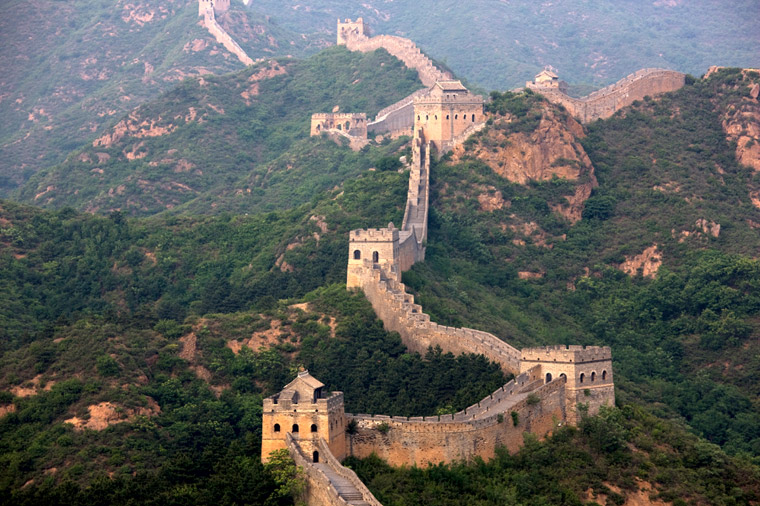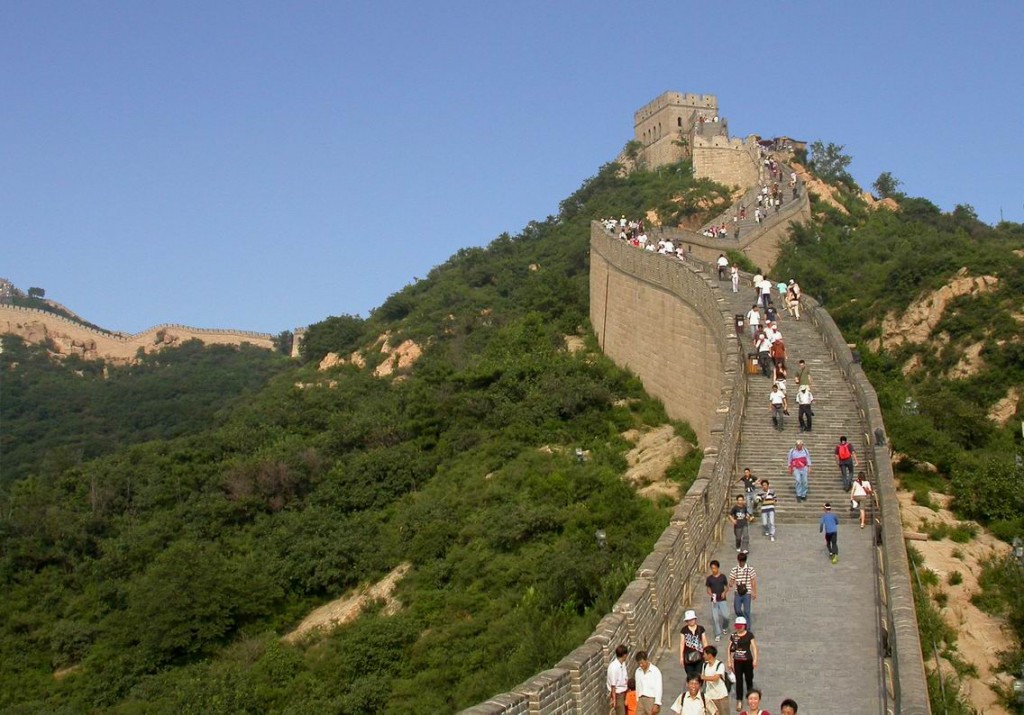A massive network of fortresses, strategic passes, holy temples, lofty turrets, precipitous stairs, and tactical watch towers, the Great Wall is indubitably China’s greatest source of pride. This colossal structure, when viewed from above the earth, snakes up and down across mountains, plateaus, deserts, and grasslands like the legendary dragon. It encompasses a highly diverse topography–from grasslands to undulating desert dunes; from loess plateaus to steep mountains– and many great sections, each boasting a history of its own.
While it is visible even from the moon, you don’t need to travel into space to capture its majesty. Just take a flight to Beijing, and get mesmerized by the Great Wall– a wall of transcendent proportions.
In a Nutshell
The Great Wall is considered one of the greatest man-made wonders of the world, owing to its architectural splendor and historical importance dating from the Qin Dynasty (221-207 BC) to the Ming Dynasty (1367-1644 AD). It was listed as a World Cultural Heritage Site by UNESCO in 1987. Constructed over 2,000 years from 221 BC to 1644 AD and stretching approximately 5,500 miles from east to west of China, the Great Wall was crucial in protecting agriculture and defending against marauding Huns and other warrior tribes from the north. Unfortunately though, some sections of the Great Wall now lie in ruins or have vanished altogether due to utter neglect and extreme elements.
Best Time to Visit
For usual tourists, the best time to visit the Great Wall are the months from March to May and from September to November which are spring and autumn, respectively. For the seasoned adventurer and avid photographers, though, all four seasons provide unrivalled opportunities to capture the Great Wall in its four seasons of exquisite beauty. The four seasons seem to outdo each other to provide a different aspect of the Wall. So the best time actually depends on the traveler and what he or she hopes to see from the Great Wall.
Climate
With diverse seasons come kaleidoscopic landscapes creating an enduring allure for all tourists to relish. In spring, which occurs from March to May, the Great Wall meanders among the lush greenery welcoming visitors with blooming flowers of radiance and freshness. With cool temperatures ranging from 50º to 77ºF and relatively sporadic crowds, it is indeed the best season, aside from autumn, to hit the Wall (no pun intended)!
Summer months are from June to August with temperatures hovering over 25ºC. At this time of year, the Great Wall within Beijing’s proximity basks in relatively warm and sunny blue skies. But rains befall July and August that could likely dissuade even the most avid of wall-trekkers. Authorities and hiking buffs widely recommend autumn, from September to November, as the best time to visit. With the lovely weather, one can behold a brilliant panorama of the mountains swathed in rainbow-like colors. Temperatures range from 50º to 68ºC. Wintertime in December ushers in the Chinese New Year period which is celebrated in late January and early February. At this time of year, the sections of the Wall nearest to Beijing abound with holidaymakers to welcome the onset of the incoming year. With near freezing weather though, the mountains and the wall itself are draped in snow, thus, tourists are infrequent.
Things to Do
A tour around all of the Great Wall is a formidable mission, so you need to plan how to approach it. Study the different sections and decide which one would most represent the whole Great Wall, and which one is practical for you to visit. Here are things that you can do.
1) Visit Mutianyu
The Mutianyu Great Wall is the second most well-preserved part of the Wall, with relatively less crowd than Badaling. It is also accessible because of the ski lift provided for getting to the Wall and back. You can reach it by bus or by taxi.
2) Visit Jinshanling and Hike to Simatai
For serious trekkers, a hike from Jinshanling to Simatai will be very rewarding. It will involve more than 6 miles of uphill

walking with a promise of spectacular views and clean energizing air, not to mention a good share of exercise. Bring water and snacks with you. In going down, ride a 400-m zipline over a river. The zipline ride will cost USD 7.
3) Visit Jian Kou and hike to Mutianyu
Visit Jian Kou and from the village of Xi Zha Zi, walk towards Mutianyu. The village charges USD 3.50 per person. The hike will be rough and it will take you about two to three hours of walking before you reach Mutianyu.
4) Go to the Great Wall Museum
If you have opted for the most popular section of the wall, the Badaling Great Wall, walk down the pedestrian street and climb a small hill where you will find the Circle Vision Theater. Behind it is the Great Wall Museum. There are walk-though displays of prototypes and artifacts. It must be worth mentioning that the museum has a clean bathroom, a rare commodity on that part of the Wall. Admission is free.
5) Stay One Night in An Authentic Great Wall Village
You can experience authentic peasant life in one of the villages that are located below and along many sections of the Great Wall. Many farmhouses provide rooms and village accommodations. You can choose from the more inhabited sections like Xisan Minu at the foot of Mutianyu Great Wall, or you may choose the quieter ones like Gubeikou Hexi Village at the foot of the Wohushan Great Wall. What better way to experience the Wall than to live on the villages at the base of the Wall.
Top Attractions
The Great Wall is a series of walls built from 214 BC until the 16th century by different emperors. The purpose had consistently been to ward off enemy and marauders from territory lines. The first and second categories of walls, built from 214 B.C. until 130 B.C., have deteriorated heavily even in those periods. Much of the walls that we see today are part of the third and fourth categories of walls built from the 14th until the 16th centuries. Below are sections of the Wall that deserve a traveler’s attention and interest.
1) Badaling Great Wall

The Badaling section of the Wall, doubtless the most famous, is the epitome of grandeur as it is the most well-preserved, easily accessible (it is closest to Beijing), and plainly safe to hike along than the rest of the sections. Built during the Ming Dynasty (1368-1644), this section has an average altitude of over 3,280 feet with mountain slopes that are very steep coupled with winding paths. It is located in Yanqing County, 43 miles north of Beijing. Visitors to the site could take the buses at Dongzhimen for a one-hour trip at USD 2 per person. On-site admission fee is USD7.50.
Address: Badaling, Yanqing County
